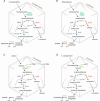Prokaryotic Organelles: Bacterial Microcompartments in E. coli and Salmonella
- PMID: 33030141
- PMCID: PMC7552817
- DOI: 10.1128/ecosalplus.ESP-0025-2019
Prokaryotic Organelles: Bacterial Microcompartments in E. coli and Salmonella
Abstract
Bacterial microcompartments (MCPs) are proteinaceous organelles consisting of a metabolic pathway encapsulated within a selectively permeable protein shell. Hundreds of species of bacteria produce MCPs of at least nine different types, and MCP metabolism is associated with enteric pathogenesis, cancer, and heart disease. This review focuses chiefly on the four types of catabolic MCPs (metabolosomes) found in Escherichia coli and Salmonella: the propanediol utilization (pdu), ethanolamine utilization (eut), choline utilization (cut), and glycyl radical propanediol (grp) MCPs. Although the great majority of work done on catabolic MCPs has been carried out with Salmonella and E. coli, research outside the group is mentioned where necessary for a comprehensive understanding. Salient characteristics found across MCPs are discussed, including enzymatic reactions and shell composition, with particular attention paid to key differences between classes of MCPs. We also highlight relevant research on the dynamic processes of MCP assembly, protein targeting, and the mechanisms that underlie selective permeability. Lastly, we discuss emerging biotechnology applications based on MCP principles and point out challenges, unanswered questions, and future directions.
Figures




References
-
- Rae BD, Long BM, Badger MR, Price GD. 2013. Functions, compositions, and evolution of the two types of carboxysomes: polyhedral microcompartments that facilitate CO2 fixation in cyanobacteria and some proteobacteria. Microbiol Mol Biol Rev 77:357–379 10.1128/MMBR.00061-12. [PubMed] - DOI - PMC - PubMed
-
- Abdul-Rahman F, Petit E, Blanchard JL. 2013. The distribution of polyhedral bacterial microcompartments suggests frequent horizontal transfer and operon reassembly. J Phylo Evo Bio 01:1–7.
Publication types
MeSH terms
Substances
Grants and funding
LinkOut - more resources
Full Text Sources
Molecular Biology Databases
Miscellaneous

